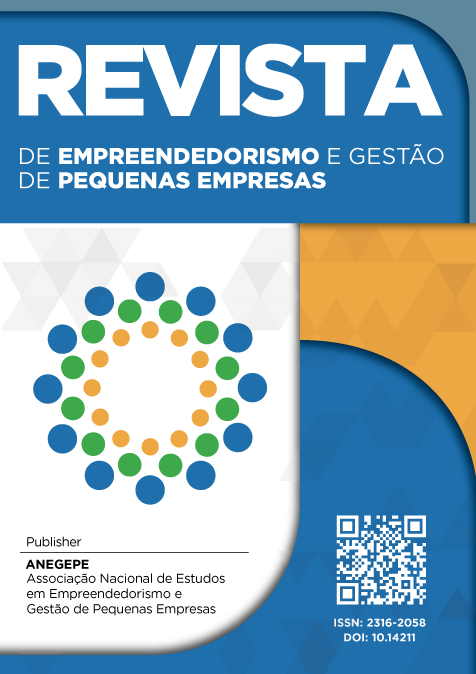From the gym to happy hour: The case of oursound
DOI:
10.14211/regepe.e1815Keywords:
Marketing, Value Generation, Teaching caseAbstract
The study's objective: portray the added value of the OurSound application to the gym, bars, and restaurants sectors and the challenges gave the need to expand sales by the owner partners. Methodology/approach: teaching case based on facts according to micro and small companies' management experience. Originality/relevance: the teaching case portrays the activities of the company OurSound, whose differential is that it is a musical interaction application offered by the owners of establishments to their customers. Main results: the reflections, learning, and possible strategies suggested by students to meet the desires of creating value and increasing sales (with the consequent expansion of associated establishments, interaction, sociability, and engagement among users) of the studied application other of similar. Theoretical/methodological contributions: offering students living in situations related to the management of micro and small businesses to have the opportunity, being supposedly in place of partners, to discuss the dilemma presented and seek alternatives to solve it.
JEL CODE: M00, M31
Downloads
References
ANT – Associação Nacional dos Restaurantes (2018). Setor de alimentação fora do ANT – Associação Nacional dos Restaurantes (2018). Setor de alimentação fora do lar encerra 2018 com crescimento de 3,5%. Recuperado de https://anrbrasil.org.br/setor-de-alimentacao-fora-do-lar-encerra-2018-comcrescimento-de-35/
Bailey, S., & Baker, J. (2014). Visual merchandising for fashion. London: Bloomsbury Publishing Plc.
Bernardez, G. (2005). Marketing para pequenas empresas: dicas para a sobrevivência e crescimento do seu negócio. Blumenau: Impressão Nova Letra.
Borges, A. F., & Lima, J. B. (2012). O processo de construção da sucessão empreendedora em empresas familiares: um estudo multicaso. Revista de Empreendedorismo e Gestão de Pequenas Empresas – Regepe, 1(1), 131-154. http://doi.org/10.14211/regepe.v1i1.17
Chernatony, L., Harris, F., & Riley, F. D. O. (2000). Added value: its nature, roles and sustainability. European Journal of Marketing, 34(1/2), 39-56. http://doi.org/10.1108/03090560010306197.
Correio, M. B. L., Correio, H. S. N., Correio, D. S. G., & Correio, M. M. C. (2015). Comunicação pós-venda como influência na fidelização do cliente: um estudo de caso na “empresa a” situada na zona sul do estado de São Paulo. Revista de Administração, 13(24), 3-21.
Di Domenico, M. (2019, março). Onda fitness movimenta US$2 bi no Brasil e só cresce. Veja como aproveitar. VocêRH. Recuperado de https://vocerh.abril.com.br/mercado-vagas/onda-fitness-movimenta-us2-bi-no-brasil-e-so-cresceveja-como-aproveitar/#:~:text=Hoje%2C%20a%20ind%C3%BAstria%20de%20atividades,mais%20lucram%20com%20o%20fitness
Dino – Divulgador de Notícias. (2018, abril). Consumo: 74% das pessoas compram de acordo com as influências das mídias sociais. Recuperado de https://www.terra.com.br/noticias/dino/consumo-74-das-pessoas-compram-de-acordocom-
as-influencias-das-midias-sociais,c4050e8fb3cf092eeb4efc051aacbfd1
be0ellfy.html
Dino – Divulgador de Notícias. (2019, janeiro). Fim de ano aquece o setor de
restaurantes, crescimento pode chegar a 4,5% neste período. Infomoney.
Kotler, P. (1996). Administração de marketing. São Paulo: Atlas.
Kotler, P. (1992). Administração de marketing: análise, planejamento, implementação e controle (2a ed.). São Paulo: Atlas.
Kotler, P., & Keller, K. L. (2012). Administração de Marketing (14a ed.). São Paulo: Pearson Education do Brasil.
Lobos. J. (1993). Encantando o cliente Externo e Interno (7a ed.). São Paulo: Editora Hamburg Ltda.
Lupoli Junior, J. G. L. (2002). Uma visão estratégica da segmentação de mercado aplicada ao business to business. Pensamento & Realidade,10(5), 44-61.
Ong, C. H., Lee, H. W., & Ramayah, T. (2018). Impact of brand experience on loyalty. Journal of Hospitality Marketing & Management, 27(7), 755-774. http://doi.org/10.1080/19368623.2018.1445055
Osterwalder, A., Pigneur, Y., & Tucci, C. L. (2005). Clarifying business models: origins, present, and future of the concept. Communications of the Association for Information Systems, 16(1), 2-40. http://doi.org/10.17705/1CAIS.01601.
Pegler, M. M. (2012). Visual merchandising and display (6a ed.). New York: Fairchild Books.
Platt, A. A., & Rocha, R. A. (2016). Estratégia mercadológica (2a ed.). Florianópolis: Departamento de Ciências da Administração da Universidade Federal de Santa Catarina – UFSC.
Porter, M. (1985). Competitive advantage: creating and sustaining superior performance. New York: The Free Press.
Sant'Anna, A. L. (2018). Marketing digital e os digital influencers: breves comentários acerca dessa ferramenta e de sua eficácia na divulgação de bens e serviços. Id on Line Revista Multidisciplinar e de Psicologia, 12(42), 27-40. http://doi.org/10.14295/idonline.v12i42.1414
Scharf, E. R., Paasch, M. R., & Silva, J. (2018). Proposta de valor em empresas do setor de moda: o entendimento de gestores de marketing e de desenvolvimento de produtos. Revista de Gestão Organizacional – RGO, 11(3), 39-59. https://doi.org/10.22277/rgo.v11i3.4334
Silva, C. R. M., & Tessarolo, F. M. (2016). Influenciadores digitais e as redes sociais enquanto plataformas de mídia. Anais do Congresso Brasileiro de Ciências da Comunicação, São Paulo, SP, Brasil, 39.
Souza, J., & Torres, M. C. A. (2009). Maneiras de ouvir música: uma questão para a educação musical com jovens: música na educação básica. Música na educação básica, 1(1), 46-59.
Tapscott, D. (2010). A hora da geração digital: como os jovens que cresceram usando a internet estão mudando tudo, das empresas aos governos. Rio de Janeiro: Agir Negócios
Downloads
Published
Métricas
Visualizações do artigo: 1784 Caso de ensino (Português (Brasil)) downloads: 122 Notas de ensino (Português (Brasil)) downloads: 136 Case study downloads: 147 Teaching notes downloads: 216
How to Cite
Issue
Section
License
Copyright (c) 2021 Djenifer Pereira dos Santos, Flávia Martins de Souza, Luiz Henrique da Silva, Tatiani Schmitt

This work is licensed under a Creative Commons Attribution 4.0 International License.
Authors who publish in this journal agree to the following terms:
-
The author(s) authorize the publication of the text in the journal;
-
The journal is not responsible for the opinions, ideas, and concepts expressed in the texts, as they are the sole responsibility of their authors;
-
Authors retain copyright and grant the journal the right of first publication, with the work published under the CC BY 4.0
License, which allows sharing the work with acknowledgment of authorship and initial publication in this journal;
-
Authors are allowed and encouraged to post their work (Submitted version, Accepted version [Manuscript accepted by the author], or Published version [Record version]) online, for example in institutional repositories or preprints, as it can lead to productive exchanges as well as earlier and greater citation of published work. REGEPE requires that authors indicate/link the published article with DOI. See the Effect of Open Access.















